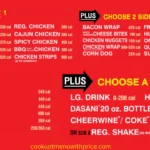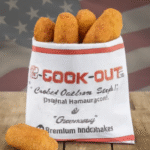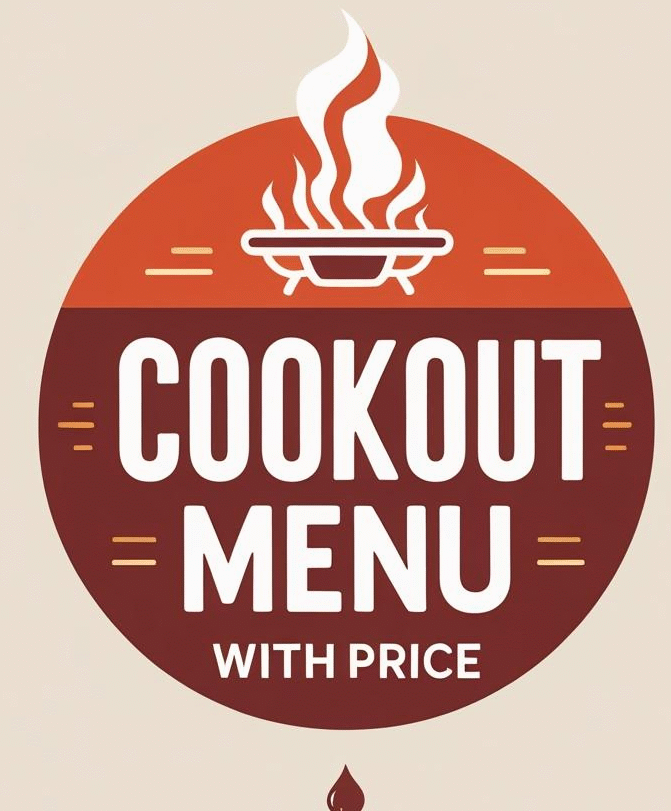Cookout Nutritional Facts:
.
In today’s fast-paced world, convenience often clashes with health goals, particularly when it comes to fast food. A beloved Southern staple, Cookout offers a tempting array of burgers, hot dogs, trays, and iconic milkshakes. But how much do you know about what’s in your favorite order?
The challenge is making informed choices when nutritional information isn’t always prominent. This can lead to confusion about hidden sugars, excessive sodium, or calorie counts that derail a diet. This comprehensive guide cuts through the guesswork, providing transparent, up-to-date nutritional data directly from official sources.
By the end of this guide, you’ll be equipped with the knowledge to navigate the Cookout menu confidently, understand the impact of your choices, identify genuinely healthier options, and even customize your order to fit your dietary needs better, empowering you to enjoy Cookout without compromising your health goals.

Important Disclaimer & Data Sourcing Transparency
- Disclaimer:
- All nutritional information in this guide is based on data officially published by Cookout and is subject to change at their discretion.
- Values are estimates based on standard product formulations and serving sizes. Customizations, regional variations, and individual preparation methods can alter nutritional content.
- Always verify information with Cookout directly, especially for severe allergies or specific dietary requirements.
- All data presented here is meticulously sourced from Cookout’s official nutrition information page or their most recent verified nutritional guides
Last Verified/Updated: [July 2025]. We are committed to regularly reviewing and updating this content to reflect any changes to Cookout’s menu or nutritional data.
- Nutritional values are provided per standard serving size or item, as indicated in the tables.
- Unless otherwise noted, data assumes standard preparation, bun included, standard condiments. Notes on the impact of customization are included where information is available or can be logically inferred.
Cookout Burgers & Sandwiches: Nutritional Breakdown
Understanding Your Main Course Choices
- Fast food burgers and sandwiches are often significant contributors to daily calorie, fat, and sodium intake. Understanding their composition is the First step toward making more conscious decisions.
- Difficulty finding up-to-date and complete nutritional information for all menu items.
- Expert Tip: Prioritise protein for satiety. Look for grilled options to reduce your fat intake.
Cookout Burgers & Sandwiches Nutritional Table
| Menu Item | Calories | Total Fat (g) | Saturated Fat (g) | Sodium (mg) | Total Carbs (g) | Sugars (g) | Protein (g) |
| Cookout Style Burger | 650 | 38 | 15 | 1100 | 45 | 8 | 32 |
| Cheeseburger | 580 | 33 | 14 | 980 | 40 | 7 | 30 |
| Bacon Cheddar Burger | 720 | 45 | 18 | 1450 | 48 | 9 | 38 |
| BBQ Burger | 680 | 39 | 16 | 1200 | 50 | 12 | 34 |
| Regular Chicken Sandwich | 480 | 22 | 5 | 950 | 42 | 5 | 28 |
| Grilled Chicken Sandwich | 380 | 15 | 3 | 800 | 35 | 4 | 35 |
| Spicy Chicken Sandwich | 520 | 28 | 6 | 1100 | 48 | 6 | 30 |
Customisation Impact for Burgers & Sandwiches
Small swaps can make a big difference when you’re trying to balance flavor with nutrition. Below, we break down common burger and sandwich customizations so you can precisely tailor your order and your health goals.
1. Hidden Calories, Carbs & Sodium
Fast-food burgers often pack more than just protein: standard buns, cheese slices, and gloppy sauces can quietly drive up your carb, calorie, and sodium intake, derailing a health-conscious meal plan.
You Didn’t See It Coming
- Bun surprise: A seemingly innocent hamburger bun adds 150–200 extra calories and 25–35 g of carbohydrates, almost as much as a small snack.
- Cheese overload: That single slice of American cheese tacks on 70–100 calories, 6–9 g of fat (much of it saturated), and 150–200 mg of sodium before you even bite into the patty.
- Sauce sneak attack: Sauces can contain hidden sugars and sodium; a single pump can add 50–80 calories and 200–300 mg of sodium.
3. Empowered Swaps & Smart Requests
- Drop the bun
- Impact: Saves 150–200 calories and 25–35 g carbs per sandwich.
- Action: Ask for lettuce wraps or “bun-less”—you’ll still get the texture without the empty carbs.
- Skip the cheese
- Impact: Cuts 70–100 cal, 6–9 g fat, and 150–200 mg sodium.
- Action: Hold the cheese or swap to a lighter option (e.g., one slice of low-fat Swiss).
- Sauce on the side/light sauce
- Impact: You control exactly how much goes on, potentially slashing 50–80 calories and 200–300 mg of sodium per pump.
- Expert Tip: Request “half sauce” or “light sauce” and dip instead of drench—your taste buds and health goals win.
- Grilled vs. Fried
- Impact: Grilled Chicken can cut total fat by 50–70% and calories by up to 100 calories compared to its fried counterpart.
- Grilled Chicken Sandwich: ~300 cal, 6 g fat
- Crispy (Fried) Chicken Sandwich: ~400 cal, 18 g fat
Quick Comparative Bullets
- Bun vs. No Bun: –200 cal & –30 g carbs
- With Cheese vs. No Cheese: –100 cal & –8 g fat
- Fried vs. Grilled: –100 cal & –12 g fat
By customizing your Burger or sandwich with just a few simple tweaks, dropping the bun, skipping the cheese, controlling sauces, and choosing grilled, you can transform a once-indulgent meal into one that fits neatly within your daily nutrition goals.
Cookout Hot Dogs & BBQ: In-Depth Nutrition
Fast-food hot dogs and BBQ plates are undeniably comforting. Still, they often pack a hidden nutritional punch, especially in sodium and unhealthy fats. When trying to stay health-conscious, one “innocent” BBQ plate can derail your daily targets in a single sitting.
Excess sodium contributes to water retention and elevated blood pressure. At the same time, saturated fat increases LDL (“bad”) cholesterol, which in turn raises cardiovascular risk over time. For example, a full Cookout BBQ Plate delivers nearly 2,445 mg of sodium, over 100% of the recommended daily limit, and 43 g of total fat, more than double what most experts suggest for a single meal.
You don’t have to skip Cookout entirely; small swaps and mindful customizations go a long way:
- Choose the basic hot dog over the larger Style version. You’ll save ~123 calories and ~518 mg of sodium immediately.
- Skip high-fat add-ons like chili, cheese, or bacon. Ask for mustard or relish only, which adds negligible calories and sodium compared to chili cheese.
- Portion control: If you crave BBQ, consider sharing a BBQ plate with a friend or taking half home.
- Hydrate with water instead of soda or sweet tea; each soda can adds 150+ empty calories and extra sugar.
Expert Tip: Sodium overload is common in fast food. To keep fat and sodium in check, opt for the smaller hot dog, skip extra sauces or cheese, and round out your meal with a side of fresh-cut okra or a vinegar-based slaw instead of fries.
These simple swaps will slash nearly half the sodium and fat, letting you enjoy your comfort food fix without blowing your daily nutrition budget.
Cookout Sides & Fries: Calorie and Macronutrient Information
Side Dishes: More Than Just an Afterthought
- Sides can dramatically increase a meal’s overall nutritional profile. Understanding their values is crucial for managing total intake.
- Expert Tip: Portion control is key; consider sharing sides or choosing smaller portions.
Cookout Sides & Fries Nutritional Table
| Menu Item | Serving Size | Calories | Total Fat (g) | Sodium (mg) | Total Carbs (g) | Protein (g) |
| French Fries (Small) | 1 serving | 320 | 16 | 280 | 40 | 4 |
| French Fries (Medium) | 1 serving | 450 | 22 | 400 | 55 | 6 |
| French Fries (Large) | 1 serving | 600 | 30 | 550 | 75 | 8 |
| Onion Rings | 1 serving | 500 | 28 | 700 | 55 | 7 |
| Hushpuppies | 1 serving | 400 | 20 | 600 | 45 | 5 |
| Coleslaw | 1 serving | 250 | 20 | 300 | 15 | 1 |
| Side Salad (no dressing) | 1 serving | 50 | 0 | 10 | 10 | 3 |
Healthier Side Swaps
Your default sides, such as Regular Fries (347 cal, 17 g fat) and Onion Rings (256 cal, 14 g fat), satisfy cravings but also flood you with excess calories and unhealthy fats, making it tougher to stay on track with your health goals.
Over time, relying on fried sides can contribute to mid-afternoon energy crashes, unwanted weight gain, and elevated cholesterol levels. For health-conscious diners who still want flavor and crunch, these traditional options can feel like a roadblock rather than a treat.
Solution: Swap in nutrient-forward sides:
- Garden Salad: A light, crisp option that keeps calories in check. Although exact values vary by location, Cookout’s Fresh Garden Salad is widely regarded as a “low-calorie, nutritious, and light” choice.
- Fruit Cup: When available, a mixed fruit cup delivers natural sweetness and hydration, typically around 70 calories and 0 g fat per cup, based on USDA data
A Garden Salad provides fiber, vitamins, and micronutrients that support digestion and sustained energy, whereas fried sides largely contribute empty calories.
Expert Tip: Always ask for dressing on the side and use a drizzle, better yet, choose a vinaigrette to limit saturated fat. And remember: adding a Fruit Cup to any meal is an effortless, under 100-calorie way to boost your vitamin and antioxidant intake without sacrificing flavor.
Cookout Milkshakes & Floats: Sweet Indulgence Analysis
The Scoop on Shakes and Floats
- Cookout is famous for its extensive milkshake menu, but these indulgent treats are often calorie- and sugar-filled.
- Struggling to identify genuinely ‘healthier’ or lower-calorie options within a fast-food menu.
- Expert Tip: Be cautious of hidden sugars; many shakes can contain surprisingly high amounts of added sugars.
- Treats in moderation; enjoy your favorite treats in smaller portions, balancing them with healthier choices throughout the week.
Cookout Milkshakes & Floats Nutritional Table
| Menu Item | Calories | Total Fat (g) | Sugars (g) | Protein (g) |
| Vanilla Milkshake | 750 | 30 | 90 | 15 |
| Chocolate Milkshake | 800 | 35 | 95 | 16 |
| Strawberry Milkshake | 780 | 32 | 92 | 15 |
| Oreo Milkshake | 950 | 45 | 110 | 18 |
| Peach Cobbler Milkshake | 1000 | 50 | 120 | 20 |
| Root Beer Float | 450 | 15 | 60 | 8 |
Managing Your Sweet Tooth
Cook Out’s indulgent shakes are a sugar powerhouse. A Fresh Banana Shake delivers 538 calories in a 876-gram serving. In comparison, a Double Chocolate Shake contains 650 calories, 118 grams of sugar, 129 grams of carbs, 17 grams of fat, and 15 grams of protein per 33 ⅝ oz serving.
As the American Heart Association advises, a single shake can exceed the recommended daily sugar limits 4–5 times the 25 g (6 tsp) limit for women and over three times the 36 g (9 tsp) limit for men. Rapid blood-glucose spikes from such a sugar load often lead to energy crashes, mood swings, and relentless cravings. Over time, habitually overshooting these limits increases the risk of insulin resistance, weight gain, and cardiovascular issues.
Solution: You can still enjoy a cookout shake just smartly and sparingly.
- Portion Control
- Share the treat. Split a Regular Shake with a friend or family member. Cutting your portion in half instantly halves sugar (≈60 g) and calories (≈300 cal).
- Opt for smaller sizes. Choose a “junior” or reduced-size option to trim intake by 30–50% if available.
- Hydration Focus
- Water first. Begin with an 8-oz glass of water to quench your thirst, slow your sipping pace, and reduce your total shake volume.
- Skip extra sugars. Pair your shake with water or unsweetened iced tea instead of soda or sweetened beverages to avoid adding to your sugar load.
- Beyond the Calories: A Deep Dive into Macros & Micros
- Macro trade-offs. While shakes provide calcium (up to 50% DV) and protein (up to 15 g), their carb-to-protein ratio can exceed 8:1, meaning you’re ingesting mostly empty sugars.
- Daily sugar targets. To stay within the <10% of total calories from added sugar guideline in the 2020–2025 Dietary Guidelines for Americans (≈50 g on a 2,000-cal diet), treat shakes as an occasional indulgence, no more than 1–2 per week.
- Blood-glucose impact. The rapid absorption of added sugars leads to sharp glucose spikes. Balancing your shake with protein-rich sides (e.g., a grilled chicken wrap) or a fiber-rich side (e.g., a side salad) can slow absorption and stabilize blood sugar after your treat.
You can manage your sweet tooth at Cook Out without derailing your health goals by controlling portions, prioritizing hydration, understanding the macro-micro trade-offs, and treating shakes as a special‐occasion treat.
Cookout Trays & Combinations: Calculating Your Full Meal
Cook Out’s famous trays bundle an entrée, two sides, and a drink into one tidy package, but that convenience can make it tricky to know exactly what you’re consuming. Without breaking out each component, it’s too easy to overshoot your daily calorie, fat, or sodium targets.
When you assume “tray = one meal,” you risk hidden calories from premium sides (like Onion Rings or Hushpuppies) and sugary beverages. That uncounted 300–400 calories per side or an extra 200 calories from sweet tea can quietly derail a day’s worth of diligent eating.
Solution: Treat your tray like a “build-your-own” meal and sum each piece. Here’s how:
| Calories | ||
| Main Item | Cook Out Style Burger | 650 |
| 1 Side | Small Fries | 320 |
| 2 Side | Hushpuppies | 400 |
| Drink | Sweet Tea | 200 |
| Total | 1570 |
Expand to Macros & Sodium
Use your individual-item tables for fat, carbs, protein, and sodium.
For each component, note its grams of fat and carbs, milligrams of sodium, and protein.
Sum each column to get your tray total.
Actionable Tip:
If you pick a premium side (e.g., Chili Cheese Fries), swap one side for a lower-calorie option (e.g., side salad), and apply the same summing method to see your “new” total.
For beverages, replacing sweet tea with water instantly subtracts ~200 Cal, bringing your total down to 1,370 Cal, all with the same approach.
This manual calculation underscores the value of an interactive “Build Your Cookout Meal” calculator. Until such a tool exists, empower readers to do the math themselves: collect nutrition info from the individual-item tables, add up the numbers, and make swaps on the fly to hit personalized calorie and macronutrient goals. That hands-on method not only educates but also encourages mindful ordering, turning every tray into a customized, health-forward meal.
Making Healthier Choices at the Cookout
To bring an expert, dietitian-inspired perspective to your Cookout order, use these evidence-backed strategies to stay satisfied, manage blood sugar, and avoid hidden pitfalls without sacrificing flavor.
1. Prioritize Protein & Fiber
- Expert Tip: High-protein, high-fiber meals help curb hunger and blunt blood glucose spikes, allowing you to feel full for longer.
- Recommendations:
- Grilled Chicken Sandwich (skip mayo): ~25 g protein, low in added sugars.
- Plain Burger (no bun): Focus on the patty for a protein boost, and wrap it in lettuce.
- BBQ Plate Meat Portion: Order just the meat, skip, or swap sides for a fiber-rich salad.
2. Watch Out for Hidden Sugars
- Expert Tip: Sauces, buns, and shakes often contain added sugars that can significantly increase calories and glycemic load.
- Strategy:
- Request sauces on the side and use them sparingly.
- Choose water or unsweetened tea over sweetened beverages.
- If you crave a shake, consider splitting it in a regular size or opting for fruit-forward flavors (which are lower in added candy bits).
3. Combat Sodium Overload
- Expert Tip: Fast-food sodium can exceed 1,000 mg in a single item, which is nearly half of your daily maximum.
- Strategy:
- I favor grilled proteins over fried ones.
- Skip extra cheese, bacon, and sodium-dense sauces (e.g., chili).
- Limit high-sodium sides like hushpuppies or chili cheese fries.
4. Portion Control Is Key
- Expert Tip: Large portions drive overeating even when you feel satisfied.
- Strategy:
- Share a large fry or shake.
- Choose small or junior sizes when available.
5. Customize Your Order
- Expert Tip: You’re the boss of your plate, so don’t hesitate to tailor orders to your goals.
- Cookout Customization Guide:
- Swap buns for lettuce wraps.
- Hold the cheese or mayo.
- Ask for no sauce or dressing on the side.
- Substitute grilled Chicken for fried options.
6. Plan Ahead
- Expert Tip: Pre-logging meals reduce impulse choices and keep you accountable.
- Use apps like MyFitnessPal (or Cronometer) to log and preview calories, macros, and sodium before you go.
7. Balance with Water
- Expert Tip: Staying well-hydrated dampens cravings and supports digestion.
- Strategy: Always pair your meal with a full glass of water before diving into sides or shakes.
8. Don’t Forget the Produce
- Expert Tip: Adding just one serving of fruits or veggies boosts micronutrient intake and fiber.
- Strategy: Order a side salad (dressing on the side) or fruit cup whenever possible.
9. Understand Your Needs
- Expert Tip: Individual goals vary know whether you aim for weight maintenance, muscle gain, or blood-sugar control.
- Product Recommendation:
- Consult the Dietary Guidelines for Americans for baseline recommendations.
- Use a Registered Dietitian Locator (eatright.org) for personalized advice.
Understanding Common Allergens
Cook Out’s published allergen guide flags 14 of the top priority allergens, including gluten (wheat), dairy (milk), eggs, peanuts, tree nuts, soy, fish, shellfish, sesame, mustard, and sulfites, so you know exactly which items to avoid.
Actionable Guidance for Safe Ordering
- Download and Review the PDF: Before you go, grab Cook Out’s official Nutrition and Allergen PDF, provided above.
- Ask Specific Questions: When you order, say, Does the se the same fryer/batter as the hushpuppies?” or “Is there egg in that wrap sauce?” Front-line staff can often confirm prep methods.
- Customize to Avoid Cross-Contact:
- Choose grilled over fried (fryers handle multiple batters).
- Request that no shared utensils be used for sauces or batters.
- Hold mix-in toppings on shakes (e.g., skip peanut butter or candy pieces).
- Opt for Lower-Risk Items:
- Grilled Chicken (no bun): Contains soy but avoids wheat and dairy.
- Plain Hamburger Patty (no bun): Soy and wheat, only if you add a bun, or choose a lettuce wrap instead.
- Fresh Garden Salad (no dressing): This salad is naturally gluten and nut-free; you can add your oil and vinegar.
- Keep an Epi-Pen Handy & Double-Check: If your allergy is severe, always carry your medication and verify the latest allergen data online or in-store.
- Breaded vs. Breadless: Highlight which proteins come coated in wheat batter.
- Shake Mix-Ins: List which shake flavors include peanuts, tree nuts, or cookie/candy pieces.
- Sauce Spotlight: Note sauces containing eggs, ranch, dairy, cheese sauce, or gluten, some BBQ sauces.
Common Allergens at Cook Out (General Guidance)
Understanding where these top allergens hide and how to avoid them can help you order with confidence:
- Dairy
- Where it’s found: Cheese slices, milkshakes, creamy sauces (ranch, cheese sauce), and some enriched buns.
- Tip: Request no cheese items and choose dairy-free beverages (water, unsweetened tea).
- Gluten/Wheat
- Where it’s found: Buns and wraps; all breaded/fried items (hushpuppies, onion rings); certain sauces (BBQ, some marinades); Oreo-style shakes.
- Tip: Choose lettuce wraps or enjoy your protein without a wrap. Confirm that the sauces you choose are gluten-free.
- Soy
- Where it’s found: Buns and bread products, many processed ingredients (such as burger patties and hot dog skins), and shared cooking oils.
- Tip: Ask if oils are dedicated or shared; pick grilled Chicken or plain beef patties with lettuce instead of a bun.
- Eggs
- Where it’s found: Mayonnaise-based sauces, some batters (hushpuppies, fried Chicken).
- Tip: Request sauces on the side or omit them; choose unbreaded grilled items.
- Peanuts & Tree Nuts
- Where it’s found: Specific shake mix-ins (Peanut Butter, Reese’s blends); cross-contact risk in shake machines or topping bins.
- Tip: Stick to “plain” shake flavors (vanilla, strawberry), or bring your mix-in container.
- Fish & Shellfish
- Where it’s found: Although it’s not a core cookout protein, shared fryers could present a trace risk.
- Tip: Grilled items are the lowest risk; confirm fryer usage if you have severe sensitivities.
Action Steps for Allergen Safety
- Review the Official Guide: Download Cook Out’s Nutrition & Allergen PDF before you arrive.
- Ask Targeted Questions, such as, “Is this cooked in a shared fryer?” or “Does this sauce contain dairy or eggs?”
- Customize Safely: Opt for grilled over fried, hold the cheese and sauces, and use lettuce wraps.
- When in Doubt, Opt-Out: If the answer is unclear, pick an item with minimal ingredients (e.g., plain grilled Chicken, side salad without dressing).
By knowing exactly where allergens hide and arming yourself with the right questions, you can navigate Cook Out’s menu safely and enjoy your meal with peace of mind.
Eating Smart at Cookout
As you navigate Cook Out’s tempting menu, keep these core principles front and center:
- Knowledge Is Power: Use the detailed nutrition and allergen data to make choices that support your personal health goals.
- Customization Is Key: Feel empowered to request swaps, such as no bun, sauces on the side, or grilled instead of fried, to cut unwanted calories, fat, sugar, and sodium.
- Balance and Moderation: Fast food can fit into a balanced diet when you order mindfully, savor smaller portions, or share indulgent items.
- Prioritise Protein and Fibre: Lean proteins and fibre-rich vegetables or fruits keep you full longer and help stabilise blood sugar.



